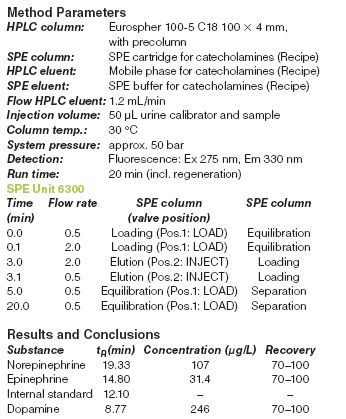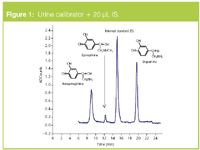On-line SPE-LC of Catecholamines in Urine with Fluorescence Detection
The Application Notebook
Catecholamines are important markers for the diagnosis and management of tumour diseases of the sympathoadrenal system. The major catecholamines are dopamine, norepinephrine and epinephrine. Urine tests have shown to be applicable to measure the level of catecholamines in the human body. Various separation methods have been used for the clean-up of catecholamines in biological fluids: solvent extraction, adsorption on alumina, ion-exchange and solid-phase extraction of a diphenylboronic acid-catecholamine complex. From the point of simplicity, reproducibility and automation the last method is the most suitable and can be realized by on-line SPE–LC. Diphenylborate forms a negatively charged complex with the diol groups of catecholamines. These complexes which are strongly retained on a polystyrene-divinylbenzene cartridge in alkaline medium (pH 8.5) can be eluted in a second step from the SPE unit directly onto the HPLC column. The separation of catecholamines is performed in isocratic mode by..
Silvia Marten, Wissenschaftliche Gerätebau Dr. Ing. Herbert Knauer GmbH, Berlin, Germany.
Introduction
Catecholamines are important markers for the diagnosis and management of tumour diseases of the sympathoadrenal system. The major catecholamines are dopamine, norepinephrine and epinephrine. Urine tests have shown to be applicable to measure the level of catecholamines in the human body. Various separation methods have been used for the clean-up of catecholamines in biological fluids: solvent extraction, adsorption on alumina, ion-exchange and solid-phase extraction of a diphenylboronic acid-catecholamine complex. From the point of simplicity, reproducibility and automation the last method is the most suitable and can be realized by on-line SPE–LC. Diphenylborate forms a negatively charged complex with the diol groups of catecholamines. These complexes which are strongly retained on a polystyrene-divinylbenzene cartridge in alkaline medium (pH 8.5) can be eluted in a second step from the SPE unit directly onto the HPLC column. The separation of catecholamines is performed in isocratic mode by adjusting the pH value in the acidic range.
Experimental
All parts in the fluid path, except the SPE and analytical columns, require passivation with a nitric acid solution. Because of the high buffer content in SPE eluent and mobile phase it is highly recommended that the filter and sieve combinations, the eluent filter and the precolumn be replaced after 250 injections. The first column inlet filter unit should be installed between the autosampler and switching valve of the on-line SPE unit. A second in-line filter unit should be placed on the outlet of the HPLC pump. For quality control of the analytical determinations we recommend using the ClinChek urine controls. These controls are available for the normal range as well as for the pathological range. The injection volume of the calibration and sample solution is 50 µL.

The on-line SPE sample preparation unit 6300 with its HPLC pump in combination with fluorescence detection dramatically streamlines the urine analysis for the determination of catecholamines. Automated sample handling, proprietary column chemistry and sensitive fluorescence detection have been combined. The system requires only a fraction of a typical sample volume. The limit of detection can be calculated with 1 µg/L and the linearity range goes up to 1500 µg/L. Its increased speed, improved accuracy and precision clearly demonstrate the advantage of this hyphenation technique over standard procedures.

Figure 1
References
1. T.G. Rosanjo, T.A. Swift and L.W. Hayes, Clin. Chem., 37(10/2), 1854–1867 (1991).
2. D.J. Wang et al., Chromatographia, 31(3–4), 137–142 (1991).

Wissenschaftliche Gerätebau Dr. Ing. Herbert Knauer GmbH
Hegauer Weg 38, 14163 Berlin, Germany
tel. +49 30 809727 0 fax +49 30 801501 0
E-mail: info@knauer.net Website: www.knauer.net

Pick Your Poison. Isolation of Paclitaxel (Mar 2025)
March 7th 2025The diterpenoid, paclitaxel, which was identified as a potent chemotherapy agent for breast and ovarian cancer originates from the Pacific Yew tree. The isolation of paclitaxel from its major impurities is shown with the use of Hamilton’s PRP-1 (5 µm) HPLC column.














